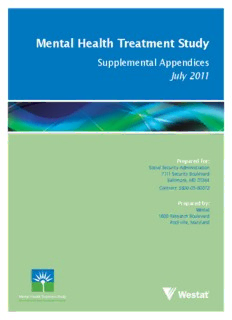
Mental Health Treatment Study Supplemental Appendices PDF
Preview Mental Health Treatment Study Supplemental Appendices
Mental Health Treatment Study Supplemental Appendices July 2011 Prepared for: Social Security Administration 7111 Security Boulevard Baltimore, MD 21244 Contract: SS00-05-60072 Prepared by: Westat 1600 Research Boulevard Rockville, Maryland Supplemental Appendices Table of Contents Appendix Page Overview: Supplemental Appendices ………………………………………………… ii A Study Implementation ………………………………….…………………… SA-A1 B CAPI Screener ………..……………………………………………………… SA-B1 C Baseline Questionnaire ……………………………………………………… SA-C1 D Treatment Quarterly Questionnaire …………………………………………. SA-D1 E Control Quarterly Questionnaire …………………………………………… SA-E1 F Final Follow-Up Questionnaire …………………………………….……….. SA-F1 Supplemental Appendices Overview This volume of the Mental Health Treatment Study (MHTS) Final Report includes the supplemental appendices to the study design chapter. These appendices include: (A) Study Implementation, (B) Screener, (C) Baseline Interview Questionnaire, (D) Treatment Group Quarterly Interview Questionnaire, (E) Control Group Quarterly Interview Questionnaire, and (F) Final FollowUp Interview Questionnaire. The Study Implementation begins with descriptive information about the study sites and the staffing. Next, is a description of the implementation procedures for the various treatment components of the study and the quality assurance activities. Finally, there is a discussion on beneficiary withdrawals, administrative drops, and adverse events. Together, this information provides the implementation context of the MHTS. The research assistant (RA) at each study site administered the questionnaires via a Computer- Assisted Personal Interview (CAPI) on laptop computers specifically programmed for interview administration. The programming included skip patterns, probes, and pre-fills where applicable. The RA conducted Screener and Baseline interviews at enrollment. The Quarterly interviews were conducted every three months. The Followup interview was conducted within one to two months of study exit. As RAs transitioned to new jobs, were on leave, or simply had too many interviews to complete, trained interviewers at Westat assisted with completing interviews. ii Supplemental Appendix A MHTS Study Implementation Supplemental Appendix A: MHTS Study Implementation Page 1 of 28 Overview of Implementation Implementation of the Mental Health Treatment Study (MHTS) was a complex effort involving many components, procedures, and policies. Presented in subsequent sections is an overview of study site and implementation procedures, including procedures for recruitment, enrollment, and randomization; data collection interviews; pre-treatment activities; treatment activities, and transition planning activities. This appendix also includes a description of the quality assurance activities applicable to participants randomized into the treatment arm, and a brief discussion of beneficiary withdrawals, administrative drops, and adverse events. Figure SA-1 presents an overview of the design and flow of the MHTS. Eligible Social Security Disability Insurance (SSDI) beneficiaries recruited into the study received a random assignment to either the treatment or control group after completing the Baseline interview. Participants assigned to the treatment group participated in a series of pre-treatment activities (including testing and service planning) and then received the intervention services and benefits. Throughout their 24- month tenure in the study, the research assistant (RA) (or in some cases a trained Westat interviewer) interviewed each enrollee (in the treatment and control groups) quarterly. Nearing the end of the 24 months treatment group participants participated in a lengthy transition process off the study. Lastly, both treatment and control group participants completed the final Followup interview. Supplemental Appendix A: Study Implementation SA-A1 Supplemental Appendix A: MHTS Study Implementation Page 2 of 28 Figure SA-1. Overview of MHTS design Recruitment Randomization Treatment Control Pre-treatment Beneficiary Interviews Beneficiary Treatment Interviews Study Exit Transition Planning Study Exit Characteristics of the Study Sites and Staffing Investigators chose the study sites primarily because they had the capability to deliver behavioral health services and IPS services to treatment group participants. However, to implement the MHTS treatment intervention fully, each study site needed to assign a dedicated Nurse Care Coordinator (NCC) and RA to fulfill crucial MHTS tasks. The NCC served in a dual role supporting both beneficiary treatment (particularly the SMM component) and the research (completing various reports). The RA served primarily in a research role on the study. The RA was responsible for recruitment, enrollment, completing the Quarterly interviews, and other research tasks. In addition to the NCC and RA, each site was required to have an adequate number of supported employment (SE) specialists available to handle a ratio of one specialist per 25 treatment group participants. Supplemental Appendix A: Study Implementation SA-A2
Description: